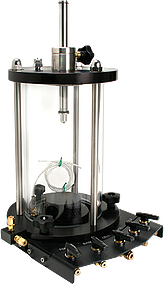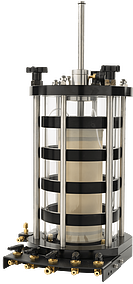
HM-4199B.XX
Triaxial Cells for up to 2.8" Samples
Features a solid base, which provides an extremely stable test platform

HM-4699B-3.XX
High-Pressure Triaxial Cells
High-Pressure Triaxial Cells for pressures to 500psi (3,500 kPa) on 3" and 4" and for pressures to 250psi on 6"
Triaxial Cells
Triaxial shear testing is a common method used to measure the mechanical properties of soils, rocks, and other granular materials. During this test, various levels of stress are applied to the sample from multiple directions, causing the specimen to react. Data from triaxial testing can be compiled in order to determine the sample’s strength and predict how the material will behave in the field.
In order to perform this test, a sample is placed within a cell that is entirely surrounded by a fluid. The cell itself applies stress in a vertical direction while the pressurized liquid applies stress perpendicularly. This causes sheer stress to develop within the sample. The load’s intensity continues to increase in intervals until the sample is unable to withstand the pressure. The cycle itself is often repeated several times for accurate results.
Triaxial cells are responsible for creating a safe and sturdy atmosphere during triaxial testing. Alongside load frames and pressure controllers, they must ensure a sturdy platform along with precise pressurizing capabilities. With a high-quality cell, setting up and testing shear strength and stress-strain relationships of soil becomes much easier.
Humboldt provides many triaxial cell options used to test triaxial shear strength. All in accordance with ASTM and AASHTO standards, the cells are built for quick and accurate results. Options for 2.8” samples, 4” samples, and 6” samples are available, along with Humboldt’s high-pressure triaxial cell option.
Humboldt maintains a large inventory of triaxial cells for immediate shipment. If you have questions or need help selecting a product, please call us at 1.800.544.7220 or use our Ask Humboldt form.

